The five-day Camiño Inglés journey that we went on last month was a feast for the senses and, in my case, an exercise in resolve due to the distance and hilly terrain. The journey in and of itself was both the mission and the reward, as I will recount in this second installment of the Camino de Santiago 2023 series.
Preparing for the Journey
A lot of preparation is needed for the Camino de Santiago, and that doesn’t just mean planning the trip and packing a backpack or suitcase.
For inexperienced hikers, they may end up biting more than they can chew with the Camino - therefore, they need to prepare themselves physically and mentally before going on it.
As for would-be pilgrims who want to undertake the Camino for religious reasons (especially the Camiño Inglés), they should be prepared to have their faith tested, because it is not what I expected from a religious standpoint.
Physical & Mental Prep Work
Aside from clearing one’s calendar for an extended period of time (at least a week), packing a suitcase, and booking tickets and rooms, the Camino de Santiago also requires would-be pilgrims to prepare their bodies and minds for the journey.
As someone who was raised living a sedentary lifestyle, I had to prepare myself physically and mentally for my first Camino last year. The physical preparation meant frequently going out for walks with my husband around the lovely city of A Coruña before we went on my first Camino, while the psychological part of the preparation included mental exercises such as training myself to think of walking less as a chore or a means to get somewhere, and more as a pleasant and leisurely activity. Having grown up in a hot and humid part of the world, walking is mostly pleasurable when it’s done in a climate-controlled environment - such as in a mall with great air conditioning.
This year, I needed less preparation of this kind as my previous Camino experience had already equipped me with what I needed to go on another. Nonetheless, the hilly terrain that the Camiño Inglés goes through can be very challenging for some people, and so, one has to bear that in mind when deciding which Camino they want to undertake.
For those who wish to undertake the Camino for religious reasons, it is important to note that religious services for pilgrims seemed to be less available on the Camiño Inglés as we saw far fewer churches and chapels along the way, and those that we did see were closed when we passed by.
Organizing the Trip
Save for booking the train tickets from A Coruña to Ferrol on our own, our entire Camino journey was organized for us by Tu Buen Camino, as I described in my previous post.
Getting to the Starting Point
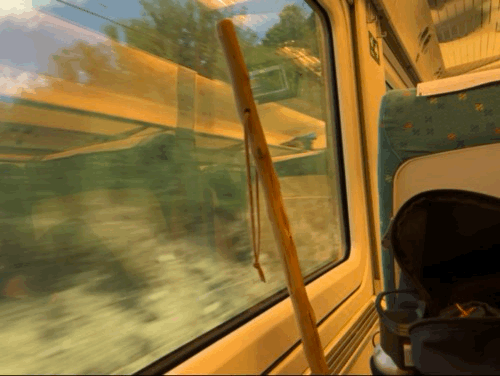 Melquiades Aserón
Melquiades Aserón Unless you already live in a Camino starting point, you will need to travel to your starting point of choice. As I mentioned in my previous post, pilgrims have the option of starting their Camiño Inglés journey from either A Coruña or Ferrol, but it didn’t really make a lot of sense starting from A Coruña because we would then have had to stay at a hotel in the same city where we live, and drop off our luggage there. In addition, we wouldn’t have qualified for the Compostela as the route from A Coruña is shorter than 100km.
Therefore, the only starting point that made sense for us was Ferrol, and we booked our train tickets on Renfe’s website right after purchasing our package from Tu Buen Camino.
The Xunta de Galicia has a great webpage that explains how to get to Camino starting points within Galicia, while this Camino services website provides information on how to get to starting points in other parts of Spain, and also as far as France and Portugal.
What to Bring
The stuff that a would-be pilgrim needs during their Camino varies widely, as it depends on factors such as:
- the time of the year (we have only done the Camino in summer),
- the type of accommodation they will be staying at during their Camino, and
- whether they’ll be using Correo’s luggage transportation service.
Basic Travel Kit
Even if the things that a pilgrim would need depend a lot on how they choose to organize their Camino, I am listing down the basic items that my husband and I have on our list in Trello to give would-be pilgrims an idea of what to take during their Camino. For those coming in from overseas, these items don’t have to be brought in from one’s country of origin as they can all be bought here in Spain:
- Sunscreen
- Sunglasses
- Waterproof poncho - It rains a lot in Galicia.
- Power bank, charging brick & cable
- Sports towel
- Insulated flask
- Bandage strips
- Hygiene kit (including soap & shampoo, as I’ve read somewhere that public albergues do not provide these)
- Small disposable plastic bags - Keep used tissues/napkins when answering the call of nature on the road in these plastic bags instead of leaving them on the ground (yes, it was distressing to see areas littered with used products). Let us be responsible & respectful guest-pilgrims by not leaving filth in exchange for hospitality received.
Long-Distance Hiking Essentials
In order to help Camino first-timers avoid and treat maladies that result due to walking long distances, here’s a list of recommended items:
- Compeed Anti-Friction Sticks and/or Vaseline - Apply generously before setting out for the day by rubbing on the soles of your feet, in between your toes, and on the backs of your ankles (basically, the parts of your foot that rubs against your shoe/shoe).
- Compeed Blister Strips - These help blisters heal faster by drying them out. Apply directly on blisters and do not remove until fully healed.
- Ibuprofen (optional) - Take judiciously when muscle pains become too uncomfortable.
These can be purchased at almost any Spanish pharmacy or at any Arenal branch.
Gear & Outfit
It is important to dress appropriately based on the day’s weather forecast:
- Wide-brimmed hat - I bought mine at a souvenir store in Sarria last year.
- Walking stick - Mine is made of wood with a metal tip, also bought at the store in Sarria.
- Comfortable clothes made from breathable fabric (in summer) or warm materials (during winter months).
- Backpack - We only carried a very light backpack as most of our stuff were in suitcases that were transported by Correos.
- Hiking shoes - I have these shoes from Columbia, and they are just awesome.
- Hiking socks - To minimize rubbing against your skin.
- (Optional but highly recommended) Smart watch - Very useful for keeping track of your journey and your vitals. I use an Apple Watch that my brother gave me as a Christmas present, while my husband uses a Garmin watch.
Religious Items
For would-be pilgrims who want to undertake the Camino for religious reasons, here are a couple of things:
- Missal - All Masses are said in Spanish, so it might be useful printing or at least familiarizing oneself with the Spanish Missal in order to keep up with what’s going on during Mass (we once saw a non-hispanophone lady who looked so lost during Mass). This website has a complete list of missals for different times of the year, while this one is bilingual.
- Rosaries and Other Items of Devotion - As previously mentioned, the Camiño Inglés is less popular among pilgrims, and so one might be hard-pressed to find and acquire religious items along the way. Therefore, it is best to bring one’s own.
The Daily Grind
The Camino quickly becomes a predictable routine for pilgrims - they wake up, take a shower, prepare their feet for a long day of hiking, have breakfast, start walking, take a break at some bar or eatery, reach their destination, check into their accommodation, take another shower, nurse any injuries, have lunch, explore the place, have dinner, prepare their backpack, and finally, sleep.
However, it is what happens in between these repeated actions that makes the Camino an unforgettable experience - socializing with other pilgrims; interacting with the kooky owners of refreshment stands; the hilarious moments in the places you stay and eat; and just the feast for the senses that you are rewarded with for embarking on the journey.
Day 0: Arrival in Ferrol
We took a train from A Coruña to Ferrol and, after checking into our hotel, my husband showed me around the city before going for lunch at a nice restaurant.
Due to its strategic location, Ferrol has an important naval base, which has resulted in the sacrifice of a lot of its inherent beauty as a coastal city for the sake of practicality - exemplified by the long stretch of wall along the militarized zone that obstructs views of the water. My husband describes it as a sad city because it has a beautiful view of the coast but it can’t be enjoyed.
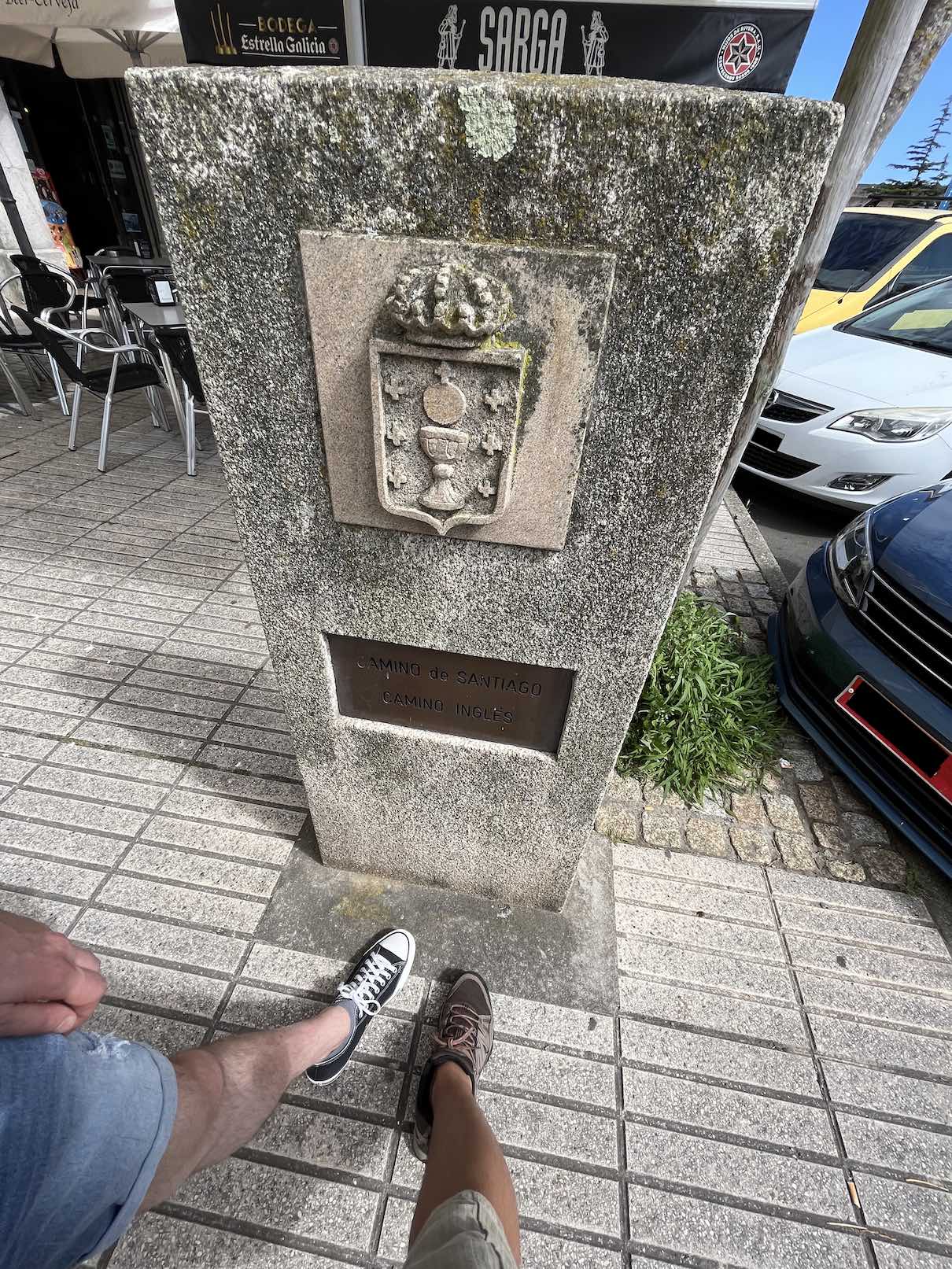 Melquiades Aserón
Melquiades Aserón In order to simulate the experience of pilgrims arriving in Ferrol from the British Isles and Scandinavia by boat in the Middle Ages, we bought passage (€8 per person) for a boat ride around the ría (Galician estuary, also described by a friend as a Spanish fjord), where we were shown historical sites such as the Castelo de San Felipe. Upon disembarking from the vessel, we walked a few meters to the milestone that marks the starting point of the Camiño Inglés.
As our hotel was located a couple of kilometers away from the docks (but still along the Camiño Inglés route), we decided to just follow the yellow arrows and mojones (Camino milestones) on our way back to the hotel, thus technically still commencing our journey from the traditional starting point.
Tip #1: If you want to get the Compostela when you arrive in Santiago de Compostela, don’t forget to get a Credencial de Peregrino and have it stamped at least once somewhere in the starting point. You need to get at least two stamps per day from different establishments.
Day 1: Ferrol to Pontedeume (28.1 km)
This stage of the Camiño Inglés passes through the municipalities of Narón, Neda, Fene, and Cabanas. Pontedeume, as explained to me by my husband, gets its name from the Eume River, which runs through a natural park.
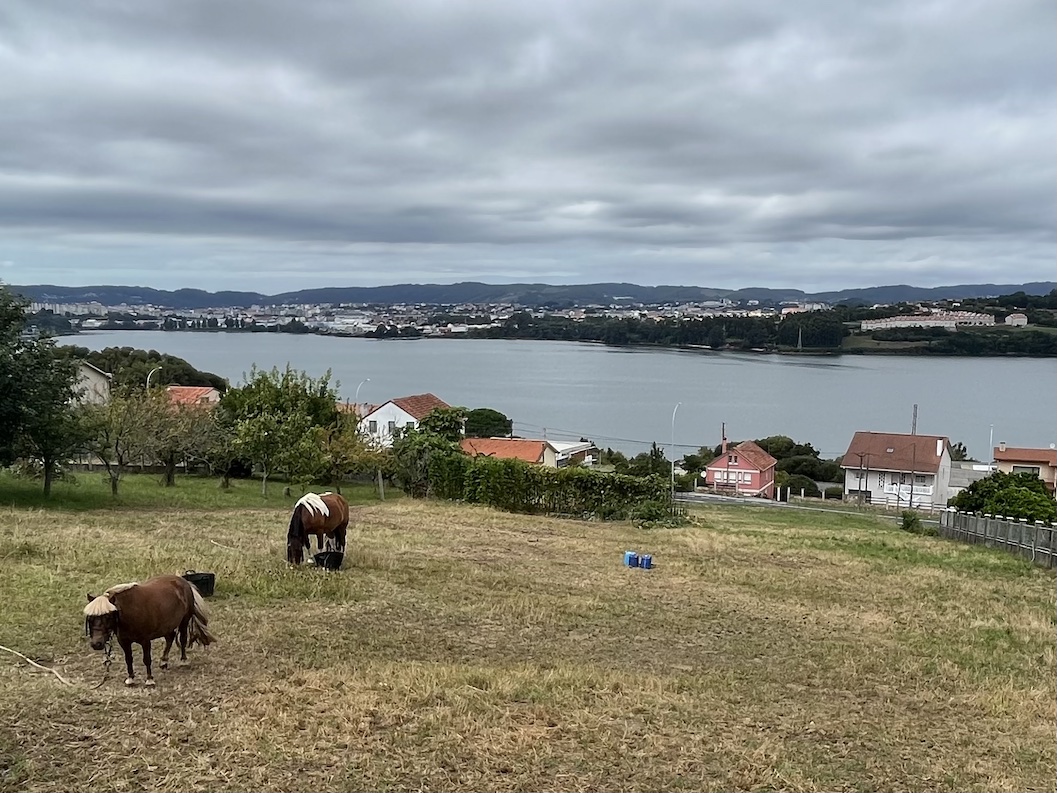 Melquiades Aserón
Melquiades Aserón I found the first half of the journey very pleasant - the terrain was flat and we were blessed with good weather (i.e. cloudy skies). On the other hand, the second half of the journey was where the terrain became challenging (i.e. hilly), and was made even more difficult when the sun came out from behind the clouds and bore down upon us - but that didn’t stop us from appreciating the funny side of things when we saw a pony that reminded us of celebrities - my husband thought it looked like Justin Bieber, while it reminded me of Nicki Minaj.
Tip #2: If you decide to do the Camino in summer, I recommend saving the ice that your drink is served with whenever you take a break at some establishment - pop the ice into your flask to keep your water nice and cool!
However, the most difficult part of this stage was arriving in Pontedeume and, to our horror, realizing that our assigned hotel was located a kilometer uphill (and a steep one at that!).
Tip #3: Check the location/elevation of your accommodation when booking it. You do not want to hike for almost 30km and then find out that you have to go mountain-climbing just to get to your hotel for some well-deserved rest - which, based on my personal experience, is enough to turn Dr. Bruce Banner into the Incredible Hulk.
On the upside, the hotel did have great breakfast service and a water cooler (which we used to refill our flasks) - before we headed out the next day.
Day 2: Pontedeume to Betanzos (19.7 km)
Since the hotel we stayed at in Pontedeume was right next to the Camino route, we were spared most of the initial climb to the top of the first hill in this part of the journey (as we had already climbed most of it the day before).
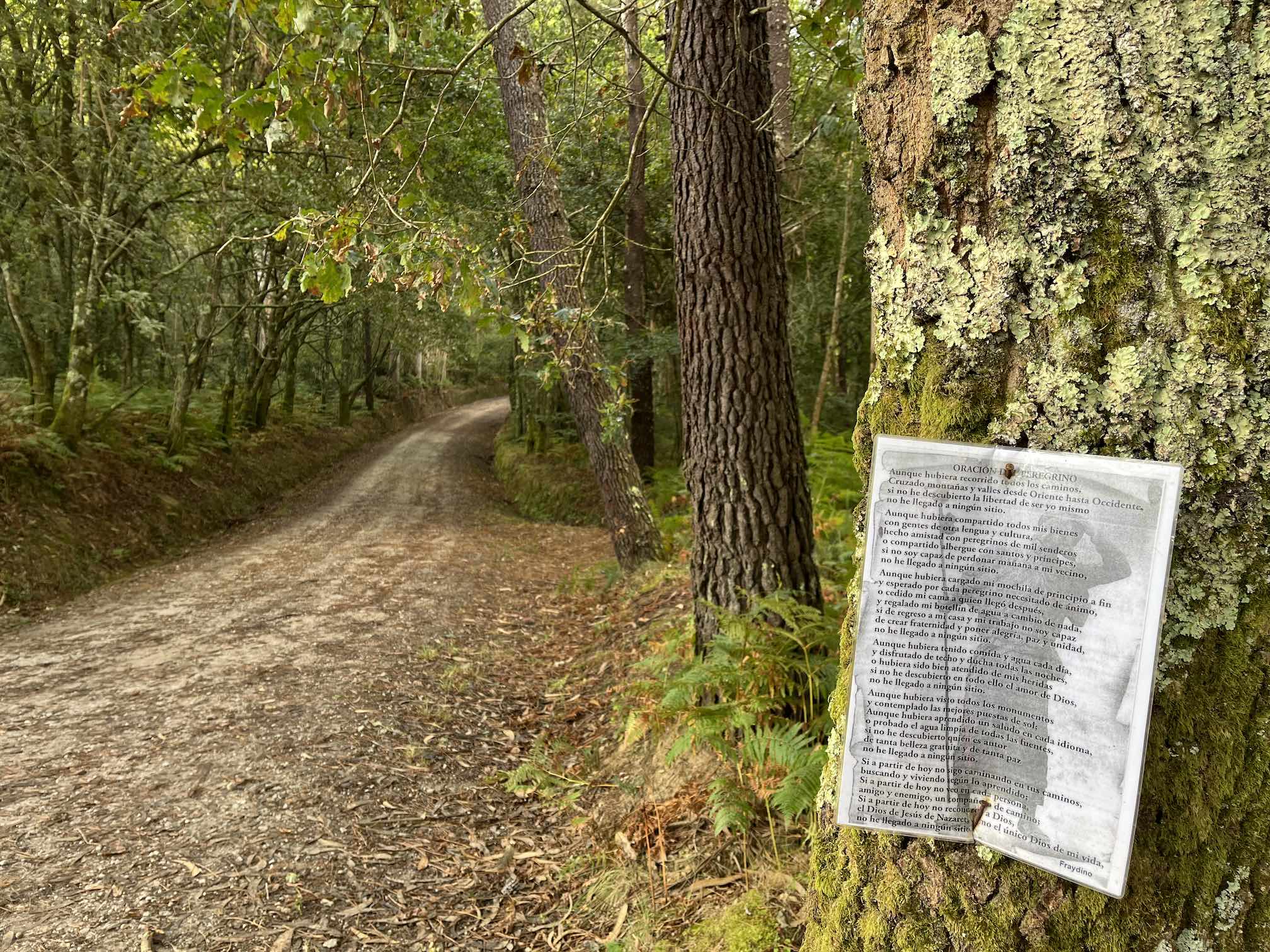 Melquiades Aserón
Melquiades Aserón We passed through the towns of Miño and Paderne before arriving in Betanzos, a city famous for its unique type of tortilla, one that is on an extreme end of the liquidness scale (I like to think that the tortilla that my husband and I make is in the Goldilocks zone of this scale). Even though this walking stage is much shorter than the previous one, I still found it challenging because it was hilly.
Tip #4: Take frequent breaks and stay hydrated - hiking on a hilly terrain can be exhausting, especially in the summer heat.
When we arrived in Betanzos, we were delighted to find that they had assigned us a wonderful hotel managed by a master hotelier, who not only thoughtfully arranged to have our suitcases brought up to our room but also offered us ice-cold beverages upon arrival. After a quick shower and a short nap, my husband and I went to Gadis, a Galician supermarket chain, to buy some snacks before going to Pilgrim’s Mass.
During Mass, the spirited parish priest called the pilgrims up to the altar to receive a blessing. Afterwards, I was able to get the priest to bless an image of San Pancracio (St. Pancras in English), that I carried with me during this Camino.
Day 3: Betanzos to Bruma (24.9 km)
We were able to head out early because the breakfast service at our hotel in Betanzos started at 7am, which meant that we could cover a lot of ground before the heat became too oppressive, as the forecast was clear skies for most of the day. This was not in our favor, as this walking stage (the second-longest one) was mostly uphill.
Tip #5: Check the weather forecast each night in order to better plan for the next day of hiking.
Halfway through the uphill climb, we stopped at a fancy (yet affordable) restaurant that was like paradise in the middle of (what felt like) nowhere - it had great food, very friendly staff, a nice ambiance, and even a live performance by a talented singer!
Tip #6: There are hardly any bars or eateries along this walking stage, so you should make full use of any that you come across.
 Melquiades Aserón
Melquiades Aserón Energized after a leisurely lunch, we continued our journey - with the afternoon sun blazing directly overhead. There were hardly any trees along the path to top of the hill, which meant there was little cover from the sun, thus making the hike even more challenging. Upon reaching the highest point, we saw what we thought was a young eucalyptus forest (a tree that pilgrims will frequently see along the Camino) - we surmised that there must have been a forest fire a while back and that was what had made the area so bare.
Tip #7: When doing this stage, make sure to bring a hat of some kind and extra water to stay hydrated.
Reaching the summit meant that we were nearly at our destination, Bruma. As our assigned hotel was about 1.5km away from the Camino route, they had a pick-up service at a bar that was well-known among pilgrims. However, we decided not to avail of the service as it just didn’t feel right getting on a van to skip a small part of the route - after all, the very essence of the Camino was to walk (i.e. caminar means to walk in Spanish).
The hotel provided a hilarious experience. My husband was mildly horrified when we got there, as he suspected that it was more of a motel that catered to the post-party needs of a nearby nightclub’s clientele. The funniest part was when we went down to have dinner and saw a smartly-dressed goat’s head mounted on the wall - I told him that it was hilarious to find such a symbol of Satan while we were doing the Camino.
Day 4: Bruma to Sigüeiro (24.2 km)
The breakfast at our hotel in Bruma was the saddest and most disappointing one, as it consisted merely of a hot drink, an orange juice (we each received a glass with a different shade of orange!), and a croissant that tasted like paper. On the bright side, their breakfast service started at 7am, so we were able to head out early (my husband couldn’t get out of there fast enough!).
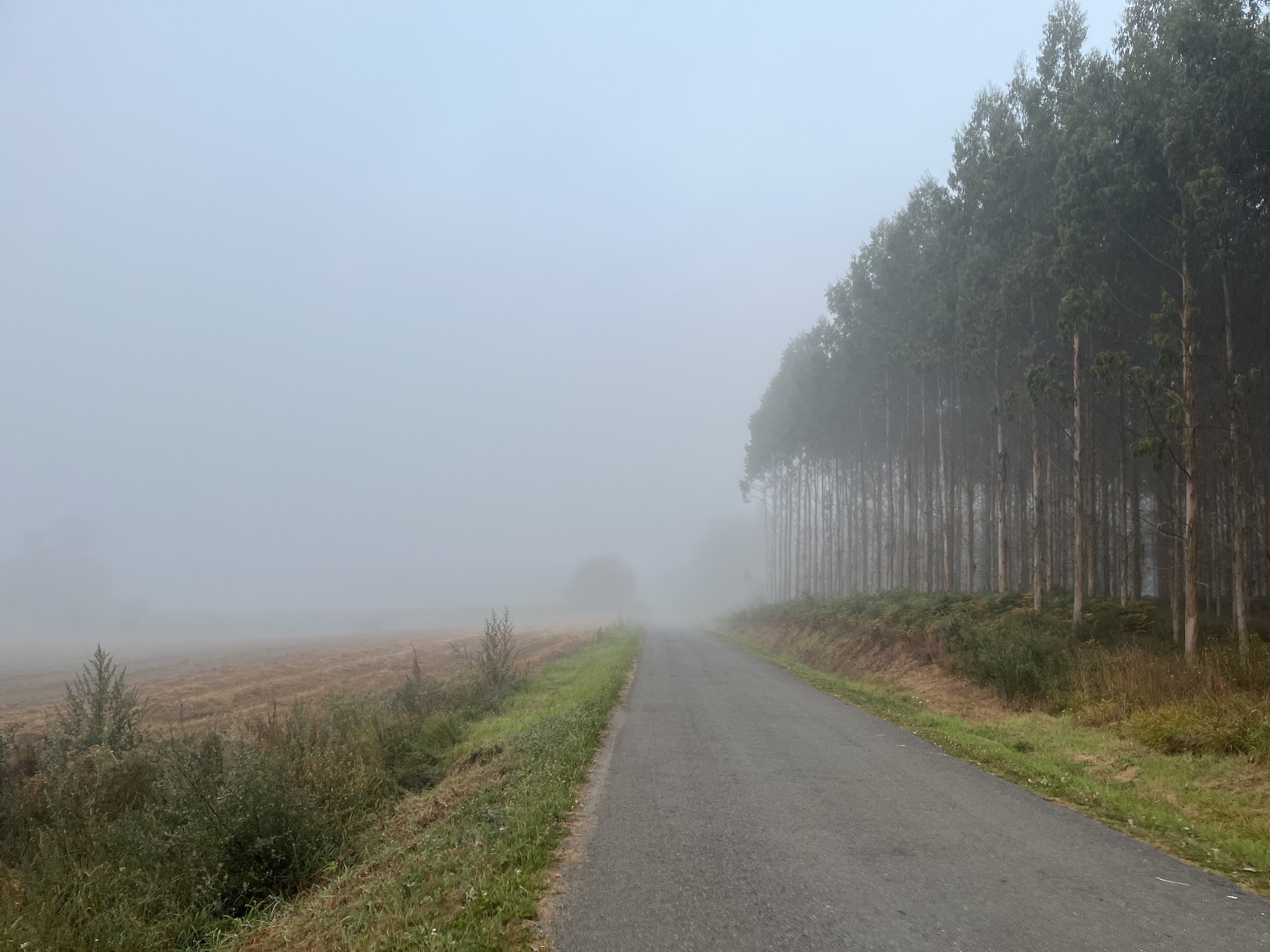 Melquiades Aserón
Melquiades Aserón It was very misty when we headed out, which made me think that Bruma somehow lives up to its name (bruma means sea mist in Spanish). It was a very pleasant and serene hike because it was nice and cool with virtually nobody around - not even passing vehicles. It was also a very easy hike because there were no more major uphill climbs for the rest of the way to Santiago de Compostela.
Most of the hike was uneventful, and the only challenge we had was finding our accommodation in Sigüeiro because the route became more confusing as we got closer to the highway that goes to Santiago de Compostela, mostly due to the lack of the iconic mojones and painted yellow arrows.
Tip #8: Pilgrims quickly develop an ability to spot mojones and yellow arrows, but will come across tricky ones which are hidden from view (such as those that aren’t directly facing you as you approach or buried in dense overgrowth), or where the paint on a yellow arrow is so faded that it’s hardly visible anymore.
When we finally arrived at our accommodation (a large house that was converted into a mini-resort), we were greeted by its very friendly manager who spoke Galician with a charming accent. As it was located a kilometer or so away from the route with no nearby stores or bars, we decided to order some snacks from our nice Galician hostess to enjoy on the porch.
Dinner was another interesting experience, because what they had was refrigerated Hacendado meals from Mercadona, including the ice cream we got for dessert. I personally found it quirky bordering on funny (but I can imagine how other pilgrims wouldn’t be impressed with the sad food options after a long day’s hike), and everything made sense when we overheard (who we thought was) one of the owners explaining to a disgruntled guest that they didn’t have a permit to cook and serve their own food.
On the bright side, the property had a porch swing where my husband and I enjoyed our dessert before turning in for the night.
Day 5: Sigüeiro to Santiago de Compostela (17.4 km)
The final day of our Camino started with a simple Spanish breakfast - a hot drink, some orange juice, a toast served with grated tomato sprinkled with olive oil and salt, and a croissant.
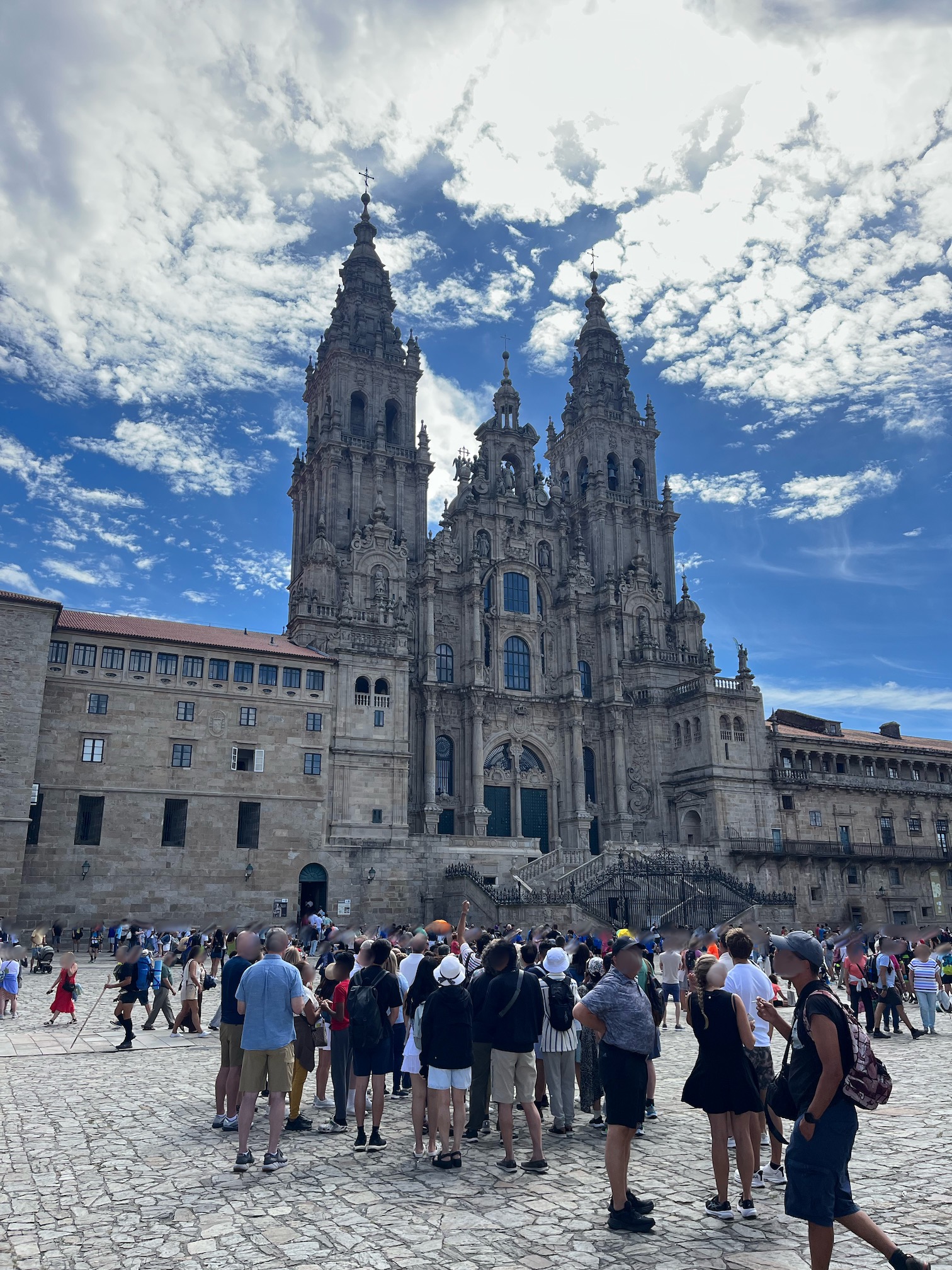 Melquiades Aserón
Melquiades Aserón It was another misty morning when we headed out, and because it was a national holiday (the Feast of the Assumption of the Virgin Mary), the final stretch of our journey to Santiago was quiet and uneventful. The landscape also steadily became more urban as we got closer to our final destination, and we came across more pilgrims - including a Californian couple who commented on the steeper climbs on the Camiño Inglés, in comparison to the Camiño Francés that they also did last year.
As the remaining distance was relatively short, we didn’t stop anywhere for a drink, but that also meant that we couldn’t add stamps to our Credenciales. Through some divine intervention, however, we came across a stand on the side of the road that had a stamp for pilgrims to use - the Lord does provide, indeed! We then walked past a small church when we arrived in Santiago that gave us our final stamp.
We struggled to find mojones and yellow arrows when we reached the city on the Camiño Inglés route, which made for a vastly different experience when we did the Camiño Francés. The Camiño Inglés route also didn’t pass through the Monte de Gozo, an absolute must for first-time pilgrims; but it wasn’t that much an issue for us because we had already seen it before, and we were focused on arriving at the Cathedral in time for the Pilgrim’s Mass.
While we arrived in time for the Pilgrim’s Mass, the Cathedral had already reached its maximum capacity, and so we decided to just check into our very nice hotel and return for the next Mass at 7:30pm.
Tip #9: You may want to time your arrival in Santiago de Compostela on a day when the Botafumeiro is used, as listed on the Cathedral’s website. However, take this piece of information with a grain of salt, as we arrived on the Feast of the Assumption but the Botafumeiro was not used during the 7:30pm Mass.
A Feast for the Senses
The Camino offers something for all senses, provided the pilgrim is receptive.
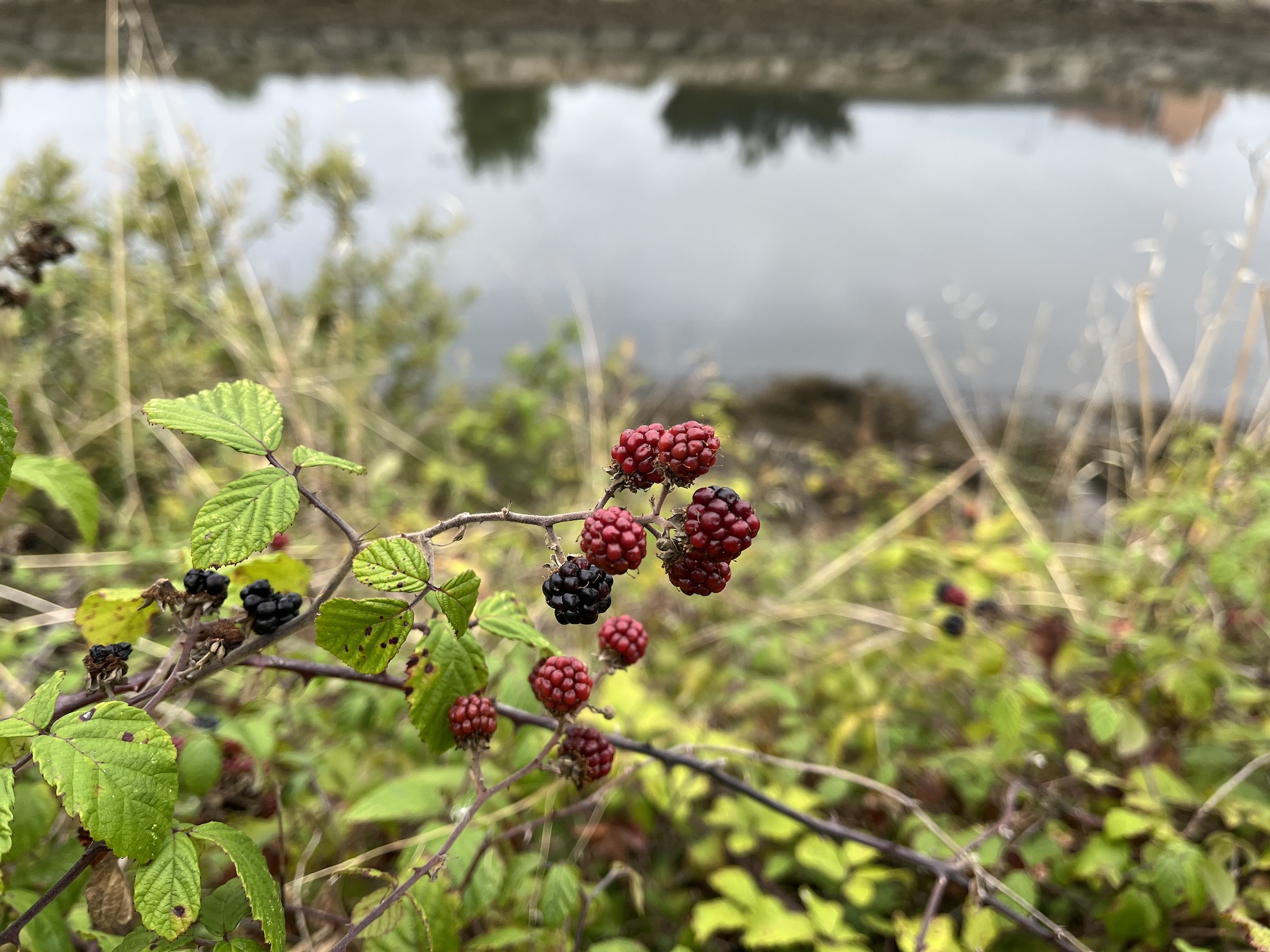 Melquiades Aserón
Melquiades Aserón Our eyes were treated to a sumptuous banquet of breathtaking views, interesting sights, Galician cultural symbols such as the cruceiro and horreo, and even enchanted forests - figurative and literal ones. On the other hand, we also saw signs of urban decay, as well as sad reminders of rural depopulation - a phenomenon that has been going on for quite some time.
The symphony of sounds along the way provided the perfect background music - the bright chirps of birds accompanied by the occasional barks of dogs heralded our mornings, progressing into the moody rustling of leaves in the wind and occasional whoosh of cars whizzing past us (and, at one point, the unsettling buzzing sound of overhead power lines), until eventually being drowned out by the hustle and bustle of urban life as we approached towns - the tempo of this orchestra of life was always marked by the steady beat of our shoes thudding against the ground.
We felt the soft, gentle breeze that helped soothe the harshness of the sun on our skin, and relished the fresh dampness of the morning mist before it gave way to the heat of the afternoon sun.
Each bite and each sip we took became a delicacy to be savored after hours of walking, and even the land had treats to offer in the form of wild zarzamoras.
The experience is made complete by the familiar pastoral smells of livestock “byproducts” with the occasional, intoxicating aroma of burning fragrant wood, as well as the earthy scent of the forest with hints of the refreshing smell of the invasive eucalyptus. That’s not all - the delicious smell of honey from bushes of sweet alyssum and, at one point, the sweet smell of lilies, would sometimes waft through the air and invite us to literally stop and smell the flowers.
Stay Tuned!
Next, I’ll be sharing some of the thoughts that came to my mind during this year’s Camiño Inglés journey!
